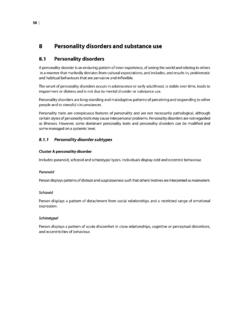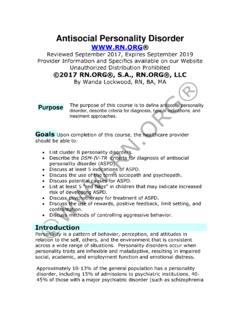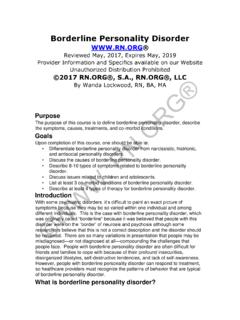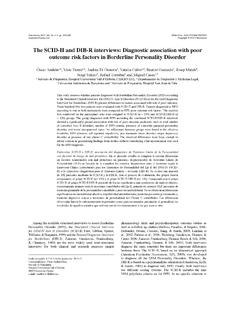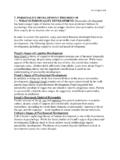Transcription of Linda Baird CHILDHOOD TRAUMA IN THE …
1 Linda Baird _____ Hakomi Forum Issue 19-20-21 Summer 2008 31 CHILDHOOD TRAUMA IN THE ETIOLOGY OF BORDERLINE PERSONALITY DISORDER: THEORETICAL CONSIDERATIONS AND THERAPEUTIC INTERVENTIONS Linda Baird , , LPC, CHT Editor s Note: It is a pleasure to have Linda Baird s helpful perspective on working with those who display the signs and symptoms of Borderline Personality Disorder in this edition of the Hakomi Forum. Normal Hakomi Therapy trainings concentrate on teaching the principles, methods, and techniques of the work with only passing reference to various clinical conditions. As the editorial policy of the Forum indicates, those who have had experience applying Hakomi Therapy to various client groups and disorders are encouraged to share their work in these pages. Linda Baird , MA, LPC, CHT is in private practice in Denver and Boulder, CO. Linda received a in Business Administration, with additional education toward a in Biochemistry from the University of Colorado.
2 She worked as a research scientist for 16 years, with particular interest in neuroscience, prior to beginning her path as a Hakomi therapist in 1995. Linda received her from Regis University in Denver. This paper is taken, in part, from her primary research paper, which included an in-depth case study at Regis, and her presentation at the 2005 Hakomi conference, as well as from her work with clients over the last ten years. Contact information: 303 507-6310. Website: ABSTRACT: Borderline Personality Disorder (BPD) has notoriously been one of the most challenging conditions to treat in therapy. This paper addresses the etiology of BPD in CHILDHOOD TRAUMA , specifically in the lack of secure attachment. The effects of TRAUMA on the development of limbic structures involved in attachment and affect regulation is discussed, as well as how traumatic events are encoded in implicit memory. The dysregulated affect states of BPD, which present as the diagnostic criteria, are considered in terms of state-dependent memory that is triggered by present day relational events.
3 Shame is discussed as a foundation of attachment failures and BPD. Key elements of individual therapy with borderline clients are discussed, including mindfulness, development of resources, establishment of a safe container within the therapeutic relationship, addressing shame dynamics, and the resolution of past TRAUMA . Therapeutic interventions are presented, both in theory and practice. Introduction When I was introduced to the concept of TRAUMA during my first psychotherapy training in 1996, while living in Boston, I had little interest. I thought it did not apply to me. I was more interested in character theory and CHILDHOOD development. Then I attended my first workshop with Pat Ogden, founder of Hakomi Bodywork, with later became Hakomi Somatics Institute and recently, Sensorimotor Psychotherapy Institute. The workshop, called TRAUMA and the Body , was a week-long experiential workshop at the Omega Institute outside of New York City.
4 As I learned about how the nervous system is affected by perceived life-threatening events, and as I was guided through experiencing this in my own body, my interest and passion for working with TRAUMA was awakened. This paper is an excerpt from a primary research paper written for the completion of my Master s degree. It combines my passion for neuroscience with the study of personality development, addressing the etiology of Borderline Personality Disorder in early CHILDHOOD TRAUMA . In particular, repeated misattunement in CHILDHOOD , when the neural circuitry is developing, can result in personality traits, or, in more extreme situations personality disorders such as BPD and Antisocial Personality Disorder. Linda Baird _____ Hakomi Forum Issue 19-20-21 Summer 2008 32 Role of CHILDHOOD TRAUMA According to van der Kolk (1988), there seems to exist a spectrum of TRAUMA -related disorders, such as BPD and multiple personality disorder, precipitated by early traumatic events that become integrated into the totality of a person s personality organization.
5 There is a high correlation between the degree of BPD psychopathology and the severity of CHILDHOOD TRAUMA (Famularo, 1991; van der Kolk, 1996; Schore 1994). Clinical descriptions of borderline personality disorder and post-traumatic stress disorder are very similar, especially when there is a history of repeated TRAUMA over time. Overlaps include disturbances in affect regulation including heightened aggression, hypervigilance and increased startle response, depression and dysphoric mood, poor impulse control including risk-taking behavior, self-mutilation and substance abuse, dissociative episodes and paranoid ideation, and intrusive memories. Van der Kolk (1987) states the most significant descriptive discrepancy between BPD and chronic PTSD is the absence in the criteria for BPD of a recognizable stressor in the patient s history (p. 115). Van der Kolk (1987) and Famularo et al. (1991) indicated that until recently, the links between CHILDHOOD traumatic events and the development of BPD in adulthood have not been consistently recognized among professionals trained to work with BPD.
6 The connection between early CHILDHOOD TRAUMA and adult relational difficulties has been completely out of awareness for many people diagnosed with BPD, as well (Perry et al., 1990). The tendency to re-enact abusive CHILDHOOD scenarios of physical, sexual, and psychological/emotional abuse will continue until the sense of injustice and fear of retribution is clarified and validated (Perry et al., 1990, p. 40). Herman et al. (1988, as cited in Goodwin, 1990) found that in a sample of clients carefully diagnosed with BPD, 81% gave a history of major CHILDHOOD TRAUMA including significant physical abuse (71%), sexual abuse (68%), and witnessing serious domestic violence (62%). There was also a significant link between CHILDHOOD sexual abuse and development of BPD that cannot be overlooked. Although borderline clients in this study did not meet criteria for PTSD as measured on the Impact of Experience Scale, the authors postulate that BPD might be conceptualized as a complicated posttraumatic syndrome and that validation and integration of the CHILDHOOD TRAUMA might be a precondition for successful treatment.
7 An earlier study by the same authors (Herman et al., 1987, as cited in van der Kolk, 1996), concluded Our explanation is that BPD is a function of having been chronically terrified during one s early development .. the superimposition of CHILDHOOD terror upon adult situations is most likely to be the key [in the development of BPD] . Adolf Stern (1938, as cited in Perry, et al., 1990) wrote the first paper differentiating borderline from neurotic disorders. The first feature he described was a sort of narcissism, meaning an early developmental disturbance of self-preserving functions, leading to psychotic-like transferences. Features included lack of maternal affection, parental quarrels, including outbursts directed at the child, early divorce, separation or desertion, cruelty, brutality, and neglect by the parents over many years duration. For many borderline clients, the connection between early TRAUMA and current problems in close relationships often remains out of awareness.
8 These clients may repetitively re-enact scenarios in which they feel threatened, attacked, or abused, and then become enraged. The characteristic self-destructive and stormy interpersonal behaviors that follow are an attempt to cope with unbearable feelings of rage, shame, guilt, and terror associated with the symbolic re-experiencing of the TRAUMA . Lack of secure attachment plays, for a number of reasons including neglect and abuse, a central role in the object relations of those who develop borderline pathology. An essential feature in BPD is the lack of development of object constancy that is generally accomplished during the second and third years of life in the separation and individuation stages (Herman et al., 1987, as cited in van der Kolk, 1996). Alder (as cited in Perry, 1990) described borderline pathology as a developmental failure in the formation of self-soothing capacities based on evocative memory.
9 These capacities derive from the child s ability to recall comforting memories of significant caregivers, even when they are not present (p. 42). Because of this inability to internalize nurturing caregivers and in turn develop the ability to self-sooth, borderline clients are prone to intense feelings of loneliness and panic. The ability to self-sooth may begin to develop in some abused children; it may be destroyed, however, when the child has no choice but to turn to the abuser for comfort (Perry, 1990). Again, Herman (1997) describes the adult relationships of those who have survived severe CHILDHOOD abuse in terms that exemplify borderline diagnostic criteria. These relationships are characterized by intense periods of searching for intimacy combined with idealization of the other person, which often put them at risk for re-enactment of CHILDHOOD abuse, alternating with periods of angry withdrawal and denigration.
10 This splitting behavior is classic characteristic of BPD: The survivor s intimate relationships are driven by the hunger for protection and care and are haunted by the fear of abandonment or exploitation.. In quest for a rescue, she may seek out powerful authority figures who seem to offer the promise of a special care taking relationship. By idealizing the person to whom she become attached, she attempts to keep at bay the constant fear of being either dominated or betrayed.. Inevitably, however, the chosen person fails to live up Linda Baird _____ Hakomi Forum Issue 19-20-21 Summer 2008 33 to her fantastic expectations. When disappointed, she may furiously denigrate the same person whom she so recently adored. Ordinary interpersonal conflicts may provoke intense anxiety, depression, or rage. In the mind of the survivor, even minor slights evoke past experiences of callous neglect, and minor hurts evoke past experiences of deliberate cruelty.

